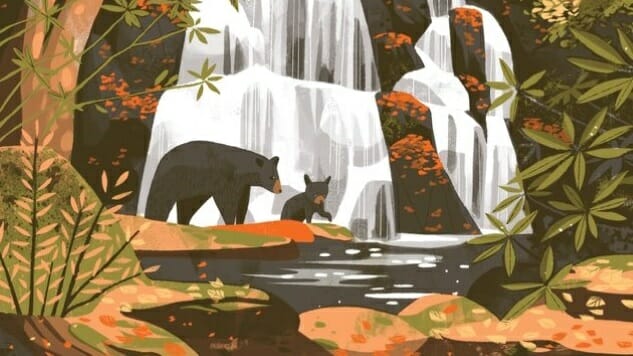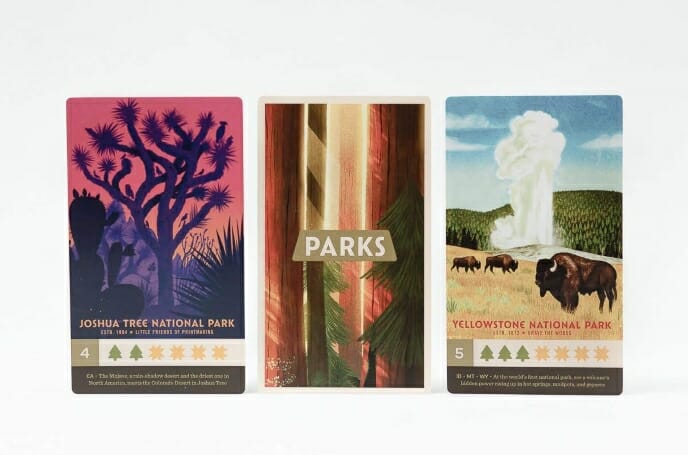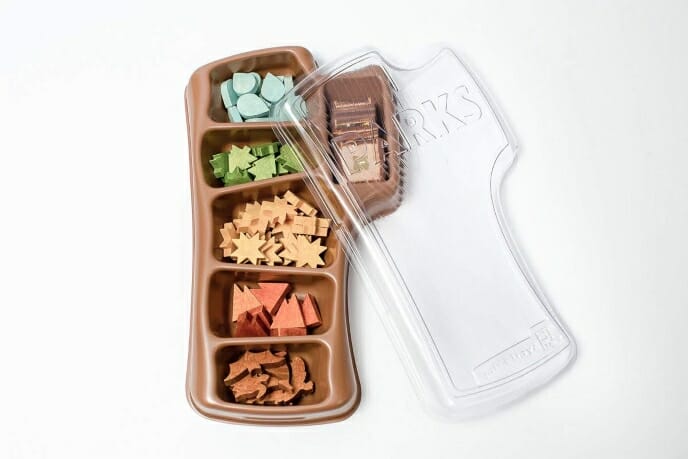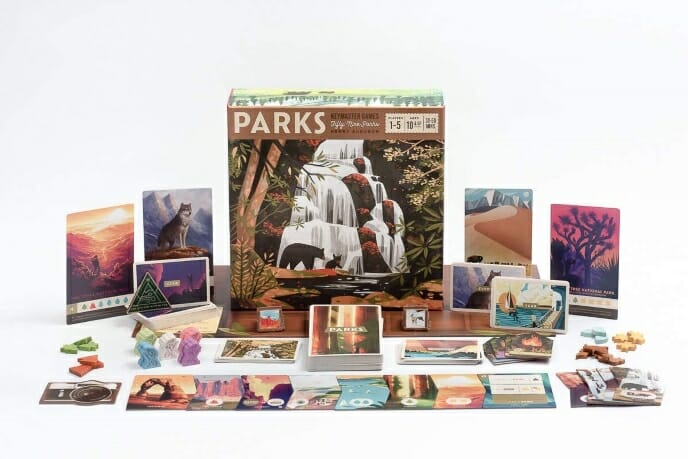
Parks was one of the top entries on my list of “2019 games I didn’t get to play but really wanted to,” especially after multiple readers suggested the game to me as one I might like. It is one of the most gorgeous games I’ve played, with artwork licensed from the Fifty-Nine Parks print series, which commissioned artists to create posters commemorating the 59 national parks at the time of the project. Beyond that, it’s a solid worker-placement and resource-management game with a few new twists to those genres, one that lets you build up a fairly potent engine by the fourth and final round.
Players in Parks get two hiker tokens each, and they traverse the game’s trail, which is reassembled in random order in each of the game’s four rounds, each representing a season. As your hiker moves left to right along the trail, you collect resources or take specific actions based on where you stop. Your choices are primarily around where to stop, not what to do on each space, as the actions available to you are rather narrowly prescribed. You’ll gather those resources with the goal of visiting the various Parks cards, each of which requires some combination of two to seven resources to visit (essentially, to buy) and awards you from two to five victory points.

The biggest way players can speed up the process—and make the game more interesting than just collect-and-buy—is through Gear cards, which you can purchase for one to three sun tokens. Gear cards give you some kind of benefit throughout the game, such as making parks cost one sun or forest token fewer than they normally would, or allowing you to exchange a resource for a wild. In the first season, you’ll probably only be able to purchase a Gear card when one of your hikers reaches the final spot on the trail, where there are three possible actions—buying a Gear card, reserving a Park card (to possibly visit later), or visiting a Park.
Each player begins the game with an objective card called a Year card that has a unique bonus worth two or three points at game-end (two if you hit the first threshold, three if you hit the second); and a Canteen card, which gives you a benefit once per season if you fill it with a water resource. Because there’s ‘weather’ in each season that involves distributing sun and water tokens along the trail, those two resources are easier to come by and the forest and mountain tokens are more scarce, so gaining gear/canteen cards that help you convert the former into the latter are highly useful.

The trail itself changes in each season as you’ll shuffle the tiles you have and add one more each time around, making the trail longer as well. This is especially important in games with more players, because you can’t just visit a site where there’s already another hiker. Each player has a campfire token that they can use twice per season to do just that; when you use it once, you flip it over, and when your first hiker reaches the end of the trail, you flip it back to its lit side and you can use it again. Most of the strategic decisions you’ll make in Parks are about how to move your hikers along the trail—including how fast to move to the end, since there are marginal benefits to getting there first—rather than which parks to visit, a process which felt rather perfunctory.
If you’re touring the nation’s parks, you’ll probably want to take a few pictures, which brings us to what is by far the weakest part of the game. Yes, you can take pictures, which require you to spend two resources in exchange for a photo that is worth one point at game-end. Once you’ve taken a picture, you get the camera token, after which you can take pictures for one resource instead of two until someone takes the token from you. At the end of a season, whoever has the camera can take another photo for one resource. It may seem odd to refer to a mechanic that gives you points as pointless, but this one is—it feels utterly tacked-on, more so because you may have to get three to five of these tokens to satisfy the objective on your Year card.

Parks is solid, and as visually appealing as any game I’ve played in a long, long time, with a plastic tray that makes setup/cleanup incredibly easy. I’m not sure that the game is that novel, though, and there’s something desultory about the whole photo-taking aspect to the game (or perhaps I just don’t get its purpose). The game plays two to five and takes about an hour, although I haven’t tried it with five and wonder if the trail becomes a cluster by the middle of each season, with a recommended age range of 10 and up that I think is justified by the straightforward mechanics and limited text within the game. I recommend it, but just didn’t quite get the hype.
Keith Law is the author of Smart Baseball and a senior baseball writer for The Athletic. His latest book, The Inside Game, is due out in April 2020. You can find his personal blog the dish, covering games, literature, and more, at meadowparty.com/blog.